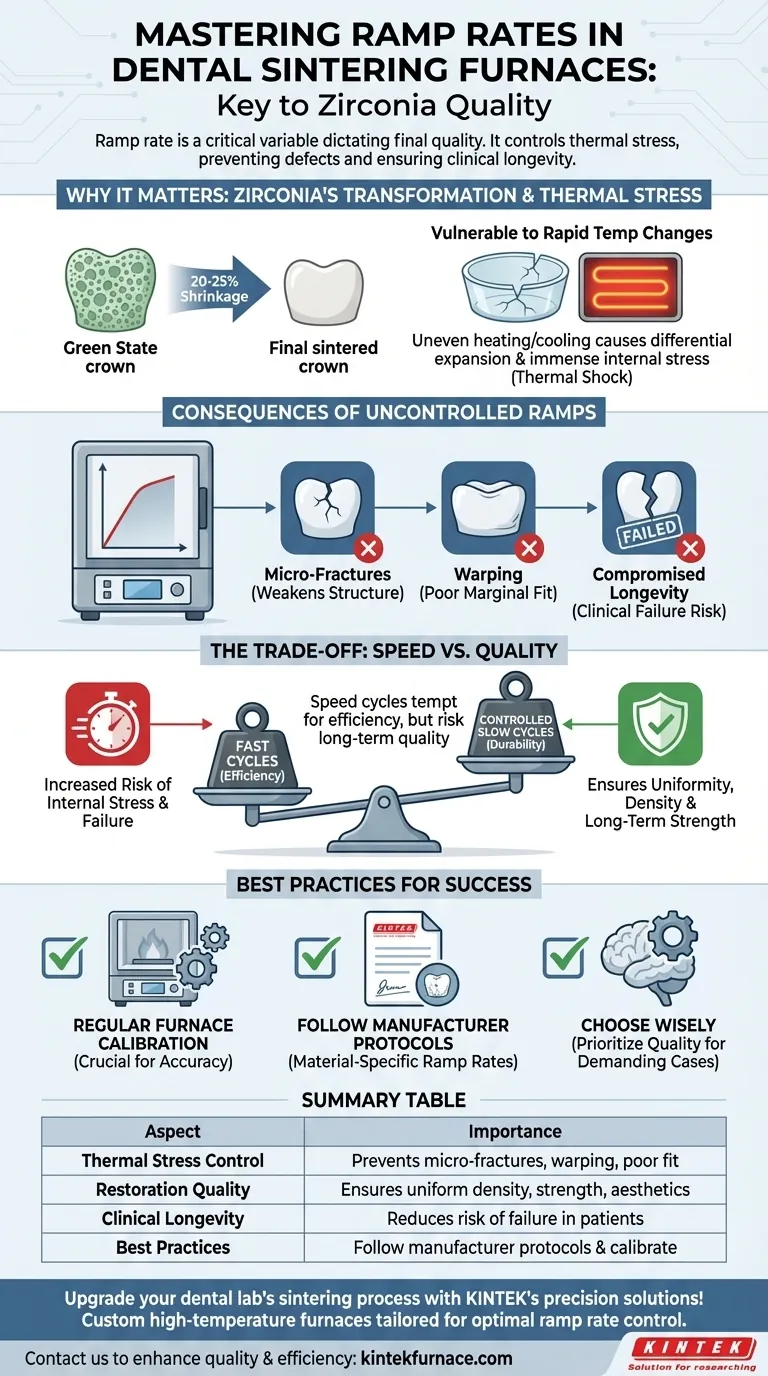In the world of restorative dentistry, the ramp rate of a sintering furnace is a critical, often overlooked, variable that dictates the final quality of a zirconia restoration. It refers to the speed at which the furnace heats up and cools down. The primary importance of controlling this rate is to manage thermal stress, preventing the micro-fractures, warping, and poor marginal fit that can compromise the strength, aesthetics, and clinical longevity of the final prosthetic.
Controlling the ramp rate isn't merely about preventing visible cracks; it's a fundamental method for managing internal stress within the zirconia. A slow, controlled temperature change ensures a uniform, dense, and durable final restoration, directly impacting its success in a clinical setting.
The Physics of Sintering and Thermal Stress
To appreciate the importance of ramp rates, one must first understand the physical transformation zirconia undergoes during the sintering process and its inherent vulnerability to rapid temperature changes.
What Exactly is a Ramp Rate?
A ramp rate is the speed of temperature change within the furnace, typically measured in degrees Celsius (°C) or Fahrenheit (°F) per minute.
It defines how quickly the furnace chamber—and the restoration within it—moves from one temperature to the next during both the heating (ramp-up) and cooling (ramp-down) phases of a cycle.
Why Zirconia is Prone to Thermal Shock
During sintering, the porous, milled "green state" zirconia undergoes a dramatic transformation, shrinking by 20-25% to achieve its final, dense state.
Rapid temperature changes cause different parts of the restoration to heat or cool at different speeds. The thin margins might heat much faster than the thick, bulky occlusal surface.
This differential in temperature creates immense internal stress. It's analogous to pouring cold water into a hot glass dish; the uneven expansion and contraction causes it to shatter.
The Consequences of an Uncontrolled Ramp
When the ramp rate is too fast, the resulting thermal stress manifests as critical defects.
These defects can range from obvious cracks to subtle micro-fractures that weaken the entire structure. It can also lead to warping, resulting in a poor marginal fit that dooms the restoration from the start.
Understanding the Trade-offs and Best Practices
While the science points to slower ramp rates, modern dental labs face pressure for faster turnaround. This creates a critical conflict between speed and quality that every technician must navigate.
The Inevitable Trade-off: Speed vs. Quality
Many modern furnaces offer "speed" or "fast" sintering cycles that use aggressive ramp rates to shorten the overall process time.
While tempting for efficiency, these cycles significantly increase the risk of introducing internal stress. A restoration may appear intact but have compromised long-term strength, making it more susceptible to failure once cemented in the patient's mouth.
The Critical Role of Furnace Calibration
A programmed ramp rate is meaningless if the furnace's temperature control is inaccurate. Over time, thermocouples can drift and heating elements can degrade.
Regular calibration is essential to ensure your furnace is actually achieving the temperature and ramp rate you have programmed. An uncalibrated furnace can inadvertently ramp too quickly, negating your careful programming and leading to inconsistent, poor-quality results.
Always Follow Material-Specific Protocols
Zirconia is not a monolithic material. Different brands, and even different translucency levels within the same brand, have unique chemical compositions.
Manufacturers provide precise sintering protocols, including recommended ramp rates, for each specific product. Deviating from these manufacturer-validated schedules is a primary cause of restoration failure.
Making the Right Choice for Your Goal
Your decision on which sintering cycle and ramp rate to use should be a conscious one based on the clinical demands of the case and the goals of your laboratory.
- If your primary focus is maximum quality and longevity: Always default to the zirconia manufacturer's recommended standard sintering cycle. Prioritize slow, controlled ramp rates for both heating and cooling to minimize stress.
- If your primary focus is faster turnaround: Use "speed" cycles with caution and full awareness of the risks. Reserve them for less demanding cases and understand the inherent trade-off you are making with potential long-term durability.
- If you are experiencing inconsistent results (chipping, poor fit): Immediately verify your furnace calibration and meticulously review the ramp rates programmed in your cycles. An incorrect or overly aggressive ramp rate is a common culprit.
Mastering your furnace's ramp rates transforms sintering from a simple heating process into a precise manufacturing discipline.
Summary Table:
| Aspect | Importance |
|---|---|
| Thermal Stress Control | Prevents micro-fractures, warping, and poor marginal fit |
| Restoration Quality | Ensures uniform density, strength, and aesthetics |
| Clinical Longevity | Reduces risk of failure in patient restorations |
| Best Practices | Follow manufacturer protocols and regular furnace calibration |
Upgrade your dental lab's sintering process with KINTEK's precision solutions! Leveraging exceptional R&D and in-house manufacturing, we provide advanced high-temperature furnaces like Muffle, Tube, and Vacuum & Atmosphere Furnaces, tailored to your unique needs. Our deep customization ensures optimal ramp rate control for flawless zirconia restorations. Contact us today to enhance quality and efficiency in your laboratory!
Visual Guide

Related Products
- Dental Porcelain Zirconia Sintering Ceramic Vacuum Press Furnace
- Chairside Dental Porcelain Zirconia Sintering Furnace with Transformer for Ceramic Restorations
- 1700℃ High Temperature Laboratory Tube Furnace with Quartz or Alumina Tube
- High Temperature Muffle Oven Furnace for Laboratory Debinding and Pre Sintering
- Vacuum Sealed Continuous Working Rotary Tube Furnace Rotating Tube Furnace
People Also Ask
- What are some common mistakes when operating dental sintering furnaces? Avoid Costly Errors for Perfect Zirconia Restorations
- What is a dental sintering furnace and what is its purpose? Achieve High-Strength Dental Restorations
- What is the sintering process in dentistry? Unlock the Strength of Zirconia Restorations
- What is the purpose of dental sintering furnaces? Transform Zirconia into Durable, High-Quality Dental Restorations
- What factors should be considered when choosing a dental sintering furnace? Ensure Quality and Efficiency for Your Lab



















